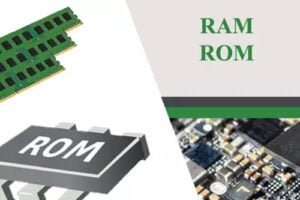Introduction to RAM and ROM:
RAM and ROM a pivotal components in modern computing systems, serving as a temporary data storage and retrieval mechanism that directly impacts a device’s performance. Ram stands for (Random access memory) and Rom stands for (Read-only memory). Unlike other types of memory, RAM is volatile, meaning it loses its data when the power is turned off. This essential feature allows for rapid read and write operations, making it an indispensable element of computing architectures.
In essence, RAM functions as a bridge between a computer’s processor and its storage devices, such as hard drives or SOLID-STATE DRIVES (SSDs). When a computer executes a program, the relevant data is loaded from storage into RAM, creating a temporary workspace for the processor to access and manipulate information quickly. This swift access is what contributes to the speed and efficiency of modern computing tasks.
The term “RANDOM ACCESS” is key to understanding RAM’s role. Unlike sequential access memory, where data must be retrieved in a specific order, RAM enables data to be accessed directly, regardless of its physical location. Each memory cell in RAM is assigned a unique address, allowing the processor to swiftly locate and retrieve the required data.

RAM comes in various types, with DDR4 (Double Data Rate 4) being one of the most common as of my last knowledge update. The speed of RAM, measured in megahertz (MHz), affects how quickly data can be read from or written to it. Larger RAM capacities also enable devices to handle more data simultaneously, enhancing MULTITASKING CAPABILITIES.
The role of RAM becomes evident when you consider scenarios like video editing or gaming. In video editing, large files are processed in real-time, and having sufficient RAM ensures smooth playback and editing without constant delays due to data retrieval from slower storage devices. Similarly, in gaming, RAM assists in loading textures, models, and other game assets swiftly, preventing lag and maintaining a SEAMLESS GAMING EXPERIENCE.
Efforts have been made to improve RAM’s efficiency and capacity over the years, with advancements such as error-correcting codes (ECC) to enhance reliability and reduce data corruption risks. Additionally, technologies like virtual memory use a portion of the storage device as an extension of RAM, allowing devices to HANDLE LARGER WORKLOADS without physically increasing RAM capacity.
Functional dimensions of RAM and ROM:
Random Access Memory (RAM) holds a critical role within contemporary computing setups, serving as a transient repository that facilitates the seamless execution of software and tasks. It functions as a rapid-access conduit, ENABLING EXPEDIENT DATA retrieval and manipulation, thereby amplifying overall system efficacy. This discourse delves into the diverse functionalities of RAM, underscoring its significance and indispensable contributions to modern computing landscapes.
RAM functions as a transient data repository, diverging from persistent storage mediums such as hard drives or solid-state drives. It promptly houses data actively engaged by the CENTRAL PROCESSING UNIT (CPU). When an application or file is initiated, it is promptly loaded into RAM, optimizing data accessibility and engendering a fluid user interface.
In conclusion, RAM stands as a vital component of modern computing systems, facilitating quick data access and manipulation for a range of tasks. Its ability to provide rapid read and write operations, along with its role as a temporary workspace for the processor, makes it an indispensable contributor to overall system performance. As technology continues to advance, RAM will likely evolve further, enhancing computing experiences and pushing the boundaries of what is possible.

Significance and pertinence of RAM and ROM:
The paramount significance of RAM lies in its capacity to facilitate multitasking and the concurrent execution of intricate applications. When transitioning between distinct programs, the pertinent data remains ensconced within RAM, obviating the need for FREQUENT DATA TRANSFER. The surplus of RAM augments a system’s aptitude to seamlessly navigate myriad tasks concurrently, circumventing operational sluggishness.
Types of RAM and ROM:
- Dynamic RAM (DRAM): This is the most common type of RAM used in computers. DRAM requires constant refreshing of data, which makes it more energy-intensive but also cost-effective. DDR (DOUBLE DATA RATE) is a variant of DRAM commonly found in modern systems (e.g., DDR4, DDR5), offering increased data transfer rates compared to older versions.
- Static RAM (SRAM): SRAM is faster and more stable than DRAM, as it doesn’t require constant refreshing. It’s often used in cache memory, providing high-speed access to frequently used data by the CPU. However, SRAM is more expensive and used in smaller quantities due to its higher cost.
- Synchronous Dynamic RAM (SDRAM): SDRAM synchronizes itself with the system’s clock speed, enhancing data transfer rates. It is used in older systems and has variants like SDR SDRAM and DDR SDRAM.
- Graphics RAM (GRAM): Also known as Video RAM (VRAM), this type of RAM is dedicated to GRAPHICS PROCESSING UNITS (GPUs). It stores graphical data such as textures, frame buffers, and other visual elements required for rendering images and videos.
Amazon Basics High-Speed Male to Female HDMI Extension Cable – 10 Feet, Black
Conclusion of RAM and ROM:
In conclusion, RAM plays a pivotal role in modern computing by providing quick and temporary data storage for the CPU. Its ability to store and retrieve data rapidly directly influences a computer’s speed and multitasking capabilities. Understanding the different types of RAM and their respective functions can assist users in making informed decisions when purchasing or upgrading computer systems.
Introduction to RAM and ROM:
Read-only memory, commonly known as ROM, is a fundamental component of electronic devices that plays a crucial role in the storage and retrieval of essential data. Unlike other forms of memory, ROM retains its contents even when the device is powered off, making it an indispensable tool for storing critical information that needs to be preserved over time.
ROM’s primary distinction lies in its “READ-ONLY” nature. This means that the data written to ROM during the manufacturing process remains fixed and cannot be altered under normal operating conditions. This permanence makes it an ideal choice for storing essential system instructions, firmware, and other CORE FUNCTIONALITIES that are vital for the device’s proper functioning.
The utilization of ROM spans a wide spectrum of electronic devices, ranging from traditional computers to contemporary smartphones, gaming consoles, embedded systems, and beyond. It serves as the repository for essential boot-up instructions, initialization routines, and critical low-level software that kickstarts the device’s operations. These instructions are etched into the ROM during the manufacturing phase, making it a non-volatile memory that withstands power cycles and retains its content without any active power source.

The advent of flash memory technology has also revolutionized the concept of ROM. Flash memory retains data even without power, much like traditional ROM, but it allows for convenient and BLOCK-BASED REWRITING, enabling frequent updates. This technology finds widespread use in portable storage devices like USB drives, memory cards, and solid-state drives (SSDs).
Functional dimensions of RAM and ROM:
- Data Storage: ROM is used to store permanent data, such as firmware and software instructions that are essential for the functioning of electronic devices. This data cannot be modified or erased by normal computer operations.
- Bootstrapping: ROM plays a critical role in the BOOT-UP PROCESS of a computer or device. It contains the initial instructions needed to start up the hardware and load the operating system.
- Firmware: Many devices, such as smartphones, printers, and routers, have firmware stored in ROM. Firmware is software that is permanently programmed into the device and controls its basic functions.
- Embedded Systems: ROM is commonly used in embedded systems where stability and reliability are paramount. Devices like microwave ovens, CAR ENGINE CONTROLLERS, and medical equipment often use ROM to store fixed routines and settings.
- Security: Some ROM types, like Mask ROM (MROM), provide secure storage of sensitive data, such as encryption keys, since the data cannot be altered or tampered with.
Significance and pertinence of RAM and ROM:
Read-only memory (ROM) holds a distinctive place in the realm of computer hardware due to its enduring significance and pertinence. In stark contrast to other forms of memory, ROM remains unalterable once data is written onto it during manufacturing. This inherent immutability empowers ROM to serve as the bedrock for fundamental system functions, ranging from the initialization of hardware components to the BOOTSTRAPPING OF OPERATING SYSTEMS.
The significance of ROM lies in its role as a non-volatile memory source, a trait that ensures the preservation of critical data even in the absence of power. This is crucial for safeguarding system-level instructions that are pivotal for the machine’s operation. The unchangeable nature of ROM is particularly valuable in scenarios where data integrity and authenticity are paramount, such as in embedded systems, FIRMWARE, and low-level programming.
The pertinence of ROM extends to diverse applications across various domains. In the realm of consumer electronics, it underpins the core functionalities of devices, enabling them to start up reliably and consistently. In industrial automation, ROM plays an indispensable role in maintaining process control and stability.
Buy PTron Force X12S Bluetooth Calling Smartwatch
Types of ROM:
There are several types of ROM:
- Mask ROM (MROM): This type of ROM is manufactured with data already programmed into it during the chip’s fabrication process. It’s not REPROGRAMMABLE and is commonly used for firmware and boot-up sequences in devices.
- Programmable ROM (PROM): PROM is a type of ROM that can be programmed by the user using a device called a PROM programmer. It uses fuses or anti-fuses to store data and can only be programmed once.
- Erasable Programmable ROM (EPROM): EPROM can be erased and reprogrammed multiple times. It requires exposure to ultraviolet (UV) light to erase the stored data, making it more VERSATILE than PROM.
- Electrically Erasable Programmable ROM (EEPROM): EEPROM can be erased and reprogrammed electronically without the need for UV light. This makes it more convenient for use in devices that require frequent updates or changes to stored data.
- Flash Memory: Flash memory is a type of EEPROM that allows multiple memory cells to be erased or written in a single operation. It’s widely used in various devices, including USB drives, memory cards, and SOLID-STATE DRIVES (SSDs).
Conclusion:
“In short, Read-Only Memory (ROM) stands as a main component within computer systems, which offers non-volatile memory that retains data even without power. Its INHERENT STABILITY and inability to be altered make it ideal for storing essential system instructions and firmware. As technology advances, ROM continues to play a crucial role in powering various devices, ensuring their smooth operation and reliable functionality.”
FAQ
Q1: What is ROM?
Answer: ROM stands for Read-Only Memory. It is a type of memory that stores data permanently, even when the power is turned off. It contains FIRMWARE and instructions required for booting up and initializing devices.
Q2: What is RAM?
Answer: RAM stands for Random Access Memory. It is a volatile memory type used for temporary data storage while a device is operational. It allows for fast data access and manipulation by the CPU.
Q3) Can RAM retain data without power?
Answer: No, RAM is a volatile memory and requires continuous power to retain its data. When power is lost, the data stored in RAM is also lost.
Q4: Can RAM be upgraded?
Answer: Yes, RAM can often be upgraded by adding more memory modules to the computer. This can improve performance, especially when running RESOURCE-INTENSIVE APPLICATIONS.
Q5: What are the types of RAM?
Answer: Common types of RAM include DDR (Double Data Rate) SDRAM, DDR2, DDR3, DDR4, and DDR5. Each generation offers improved data transfer rates and efficiency.
Q6: Is RAM faster than ROM?
Answer: Yes, RAM is faster than ROM. RAM allows us to read quickly and write quick operations.
Q7: Can I upgrade the ROM of RAM?
Answer: In most cases, ROM cannot be upgraded or changed after manufacturing.
Q8: What happens if I turn off my computer?
Answer: Data stored in RAM is volatile, meaning it gets erased when the computer is turned off. ROM, being NON-VOLATILE, retains its data even when the computer is powered down.
Q9: Are smartphones and tablets equipped with ROM and RAM?
Answer: Yes, smartphones and tablets contain both ROM and RAM.
Q10: What’s the key difference between ROM and RAM?
Answer: ROM is read-only and contains permanent data, while RANDOM ACCESS MEMORY (RAM) is volatile and used for temporary data storage during active tasks.
Thanks for reading, if you like the information please press the bell icon and subscribe so that get a notification whenever new information is updated.
Read this also…
Different types of Music FOrmat | Difference between laptop and palmtop | 4 Types of Mobile Batteries
4 thoughts on “What is RAM and ROM in Mobile? | Difference between RAM and ROM”